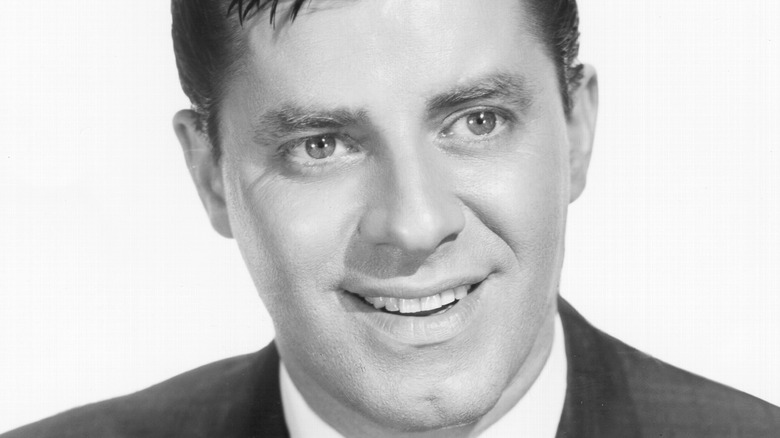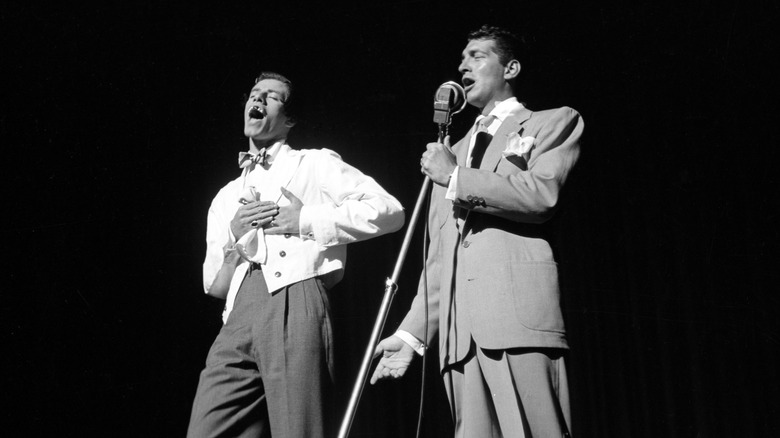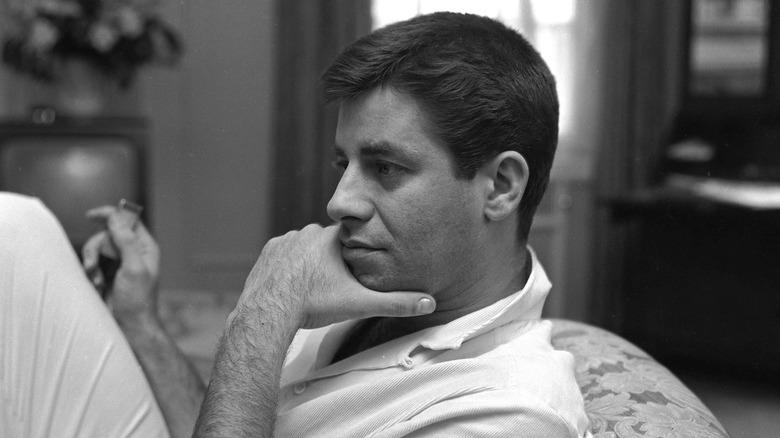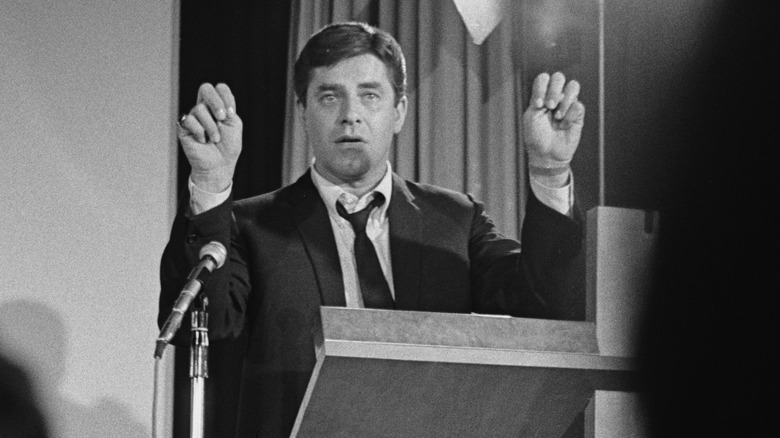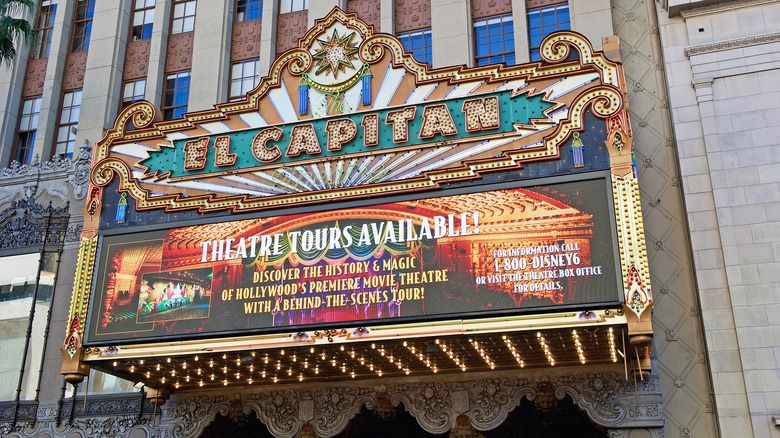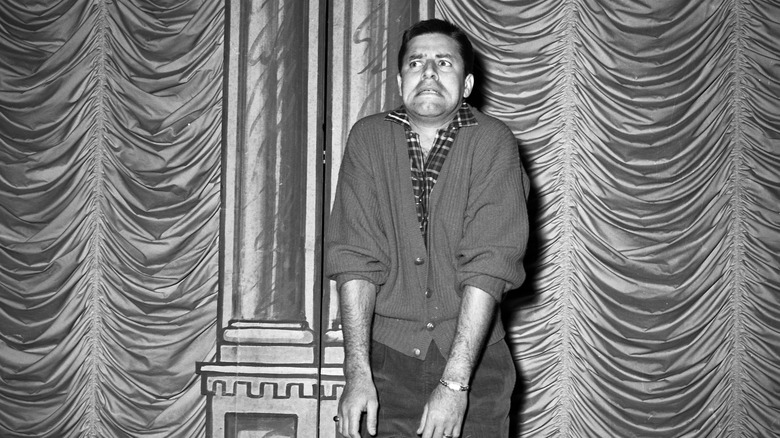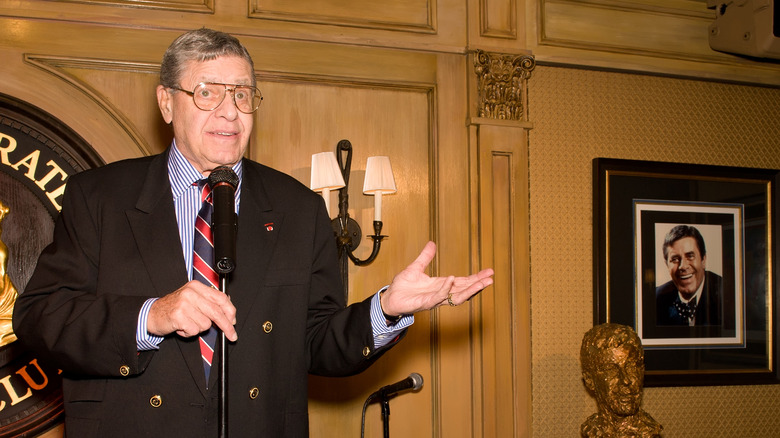The Story Of Jerry Lewis' 1963 Talk Show Flop
Jerry Lewis is one of the most revered names in comedy, and with good reason. He had a massive career that spanned from the 1940s until his death in 2017 at the age of 91. Lewis starred in films like "The Stooge" in 1951, "The Bellboy" in 1960, and "The Nutty Professor" in 1963, among many others, and at times during his career, he was the undisputed biggest name in comedy (via Britannica).
Given his long and storied career, it seems like anything Lewis would've touched during his career should've turned to gold, but that's simply not true. He had some failures, perhaps none worse than his ill-fated variety show. At the peak of his popularity, Lewis was handed the keys to a weekly talk and variety show. It was nothing short of an unmitigated disaster for both Lewis and ABC, the network that produced it. Per IMDb, the show in question was the aptly titled "The Jerry Lewis Show," the name bestowed upon multiple shows Lewis had throughout his career. Of all of them, the 1963 version is the one that is remembered, and for all the wrong reasons.
Jerry Lewis' early career
According to Britannica, Jerry Lewis — his real name was Joseph Levitch — was born into a family of vaudeville performers in 1924. While that's sort of at the tail end of the vaudeville era, the young Lewis still caught the showbiz bug. So much so, in fact, that he dropped out of high school to chase a career in comedy.
It turned out to be a good decision because it allowed Lewis free reign to focus on his career and get as much stage time as he could. That stage time came in the common venues of the era — nightclubs and burlesque houses. It was in this scene that he met his comedy partner, legendary performer and future Rat Pack member Dean Martin.
The two made for a perfect comedy team. Martin's suave and debonair demeanor was a perfect straight man and foil for Lewis' wild, borderline-neurotic on-stage antics. The two were a major success on the nightclub circuit and eventually made the jump to radio, television, and movies. However, it wasn't meant to last, as the pair eventually broke up in 1956 after a 10-year partnership. A myriad of different reasons for the breakup have been cited over the years, ranging from different work habits to the fact that Lewis carried more of the comedy load, to the rumor that their wives didn't get along (via The U.S. Sun). However, they each emerged on the other side with wildly successful solo careers.
Lewis guest-hosted The Tonight Show in 1962
The two-week period that lead directly to "The Jerry Lewis Show" happened in 1962, when Lewis had a brief stint guest-hosting "The Tonight Show." According to Britannica, "The Tonight Show" debuted on NBC in 1954 with its first host Steve Allen and essentially invented the late-night genre. Allen shifted to a part-time schedule in 1956 before leaving the show completely in 1957, at which point he was replaced by Jack Paar, who stayed with the show until 1962 (via Who2).
The next host was the legendary Johnny Carson, who wound up behind the desk for 30 years. However, between Paar's departure and Carson's arrival were some guest hosts, and one of them was Jerry Lewis. According to the 2015 book "The Comedians" by Kliph Nesteroff, Lewis' turn helming "The Tonight Show " went particularly well, and he drew such massive ratings that TV executives started trying to lure Lewis to host a talk show on their networks.
ABC signed Lewis for a massive amount of money
Unlike today, where almost every broadcast network has its own late-night program — sometimes several — "The Tonight Show" was the only show of its type on television, and less than 10 years into its run it was becoming an institution. This meant that other networks had their work cut out for them if they wanted to topple "The Tonight Show" in the ratings with some late-night fare of their own. With Carson already in line to host "The Tonight Show," the huge ratings numbers Lewis earned as the show's guest host made him the prime target to host a rival show. According to The Comedians, all three networks at the time — ABC, CBS, and even NBC, who may have been on the defensive in this case — tried to nab Lewis.
ABC emerged as the victor in the Jerry Lewis sweepstakes, but it came at a massive price. They essentially gave Lewis a blank check, agreeing to every single one of his demands. Lewis wanted to do a once-a-week, two-hour show on Saturday nights. He signed a deal for $8 million per season, doing 42 episodes each year. The deal carried a five-season option that would also increase his salary. Keep in mind, that this was all in the early 1960s. "I'll be in complete control," he said at the time. "I'll be doing something I've never done before. It'll be what people want. I'm going to play it loose."
Jerry Lewis was given complete control of the show and he used it
The price ABC paid to get Jerry Lewis on board was just the beginning of what they wound up shelling out for "The Jerry Lewis Show." Obviously, the show needed a studio, but since part of Lewis' deal was that he would be given complete creative control, he requested that ABC purchase Los Angeles' El Capitan Theater, which they did.
According to Eyes of a Generation, the renovations included practical things that the theater needed to produce a television show, like cameras and a control room, but it also included adding all kinds of over-the-top accouterments like drapery and red carpets and an obscenely opulent dressing room for Lewis himself. But this was just the start, because Lewis wanted the whole theater renovated, which included renaming the venue as the Jerry Lewis Theater.
According to The Comedians, Lewis took the complete control aspect of his deal to unprecedented levels. ABC executives recalled him being vague about some aspects of the show, even simple things like what format the show would use. Perhaps most extreme, Lewis had a switching system installed that allowed him to take over control from the show's director to control camera shots mid-show, all from behind his desk.
The Jerry Lewis Show turns out to be a fiasco
"The Jerry Lewis Show" premiered on September 21, 1963 (via Eyes of a Generation). The show was thought to be ABC's foray into the late-night genre and, given Lewis' pedigree, a worthy contender to give NBC's "The Tonight Show" a run for its money. It didn't pan out that way.
The show's first guests, per The Comedians, included comedian Mort Sahl, singers Kaye Stevens and Jack Jones, plus author Clifton Fadiman, with surprise appearances from late-night pioneer Steve Allen, Jimmy Durante, and actor Robert Stack. However, even a strong lineup couldn't save "The Jerry Lewis Show."
The show suffered from several technical problems upon its debut and was eviscerated in the press. One common criticism was that the show's two-hour run-time was simply too long. In their review, Time dished out a particular sharp barb: "ABC has ... the apparent illusion that several million people want to watch 120 minutes of the scriptless life of a semi-educated, egocentric boor." Ouch.
The Jerry Lewis Show was canceled after just 13 weeks
It was readily apparent to everyone involved in the show — and frankly, even those who weren't — that "The Jerry Lewis Show" was going off the rails, and not in a good way. The show was incapable of retaining its audience, and that sent ABC executives scrambling to find a replacement because, per Eyes of a Generation, they knew that the show was a failure. Its cancellation was announced by Thanksgiving 1963, just two months into the run.
Once again, ABC had to shell out more money, this time to buy out Lewis' contract, which forced them to sink even more millions into the wounded show (via The Comedians). Despite signing a multi-season, 42 shows-per-year deal, "The Jerry Lewis Show lasted only 13 weeks. Its final episode aired on December 21, 1963. After the holidays its replacement show — a variety show called "The Hollywood Palace," which was thrown together when ABC realized just how bad the situation with "The Jerry Lewis Show" was — occupied the first hour of Lewis' time slot, while the second was given to affiliates for syndicated programming. For its part, "Palace" ran for six years.
